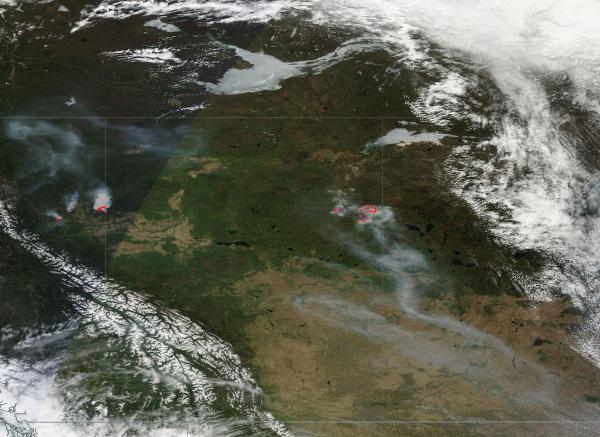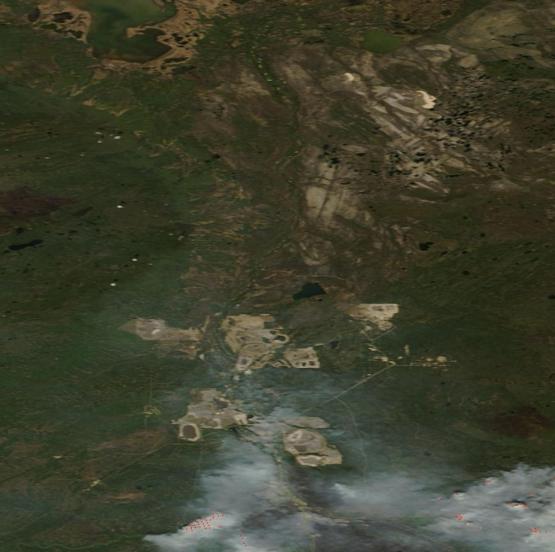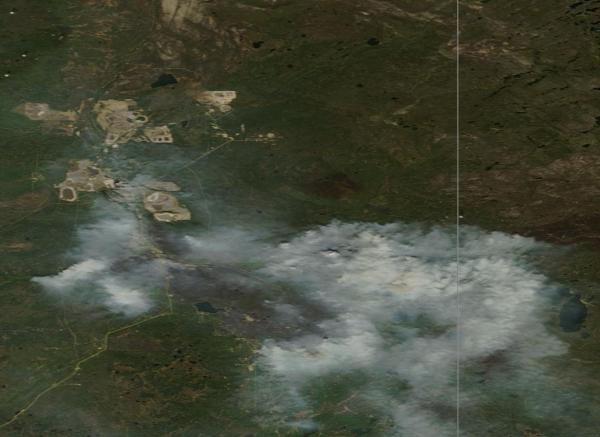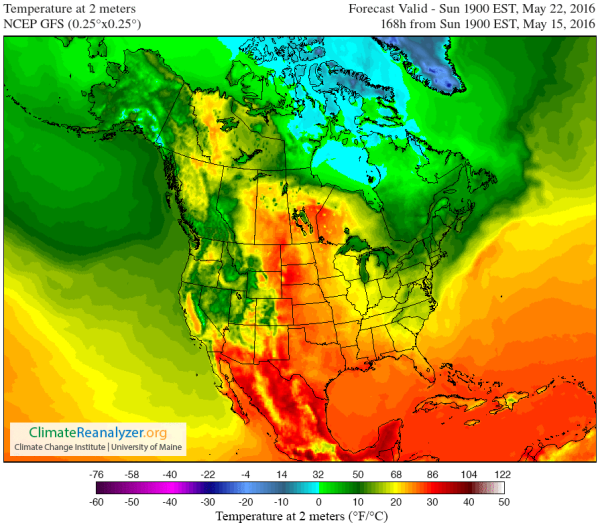Trudeau, Canadian Media Mum as Threat From Climate Change Induced Wildfires Grows
16
May,2016
To
say that this spring has produced an insane, unprecedented early
start to wildfire season in Canada would be a monster understatement.
In fact, the area of land burned over Canada is now 22 times greater
than for the same period last year.
Nearly
2000 Square Miles Have Burned in Canada So Far — And It’s Not
Even Summer Yet
By
this time (May 16) last year (2015), during the start of what was
then one of the worst fire seasons in Canadian history, a
total of about 23,000 hectares of land had burned.
This year (2016), a total of about 500,000
hectares (1930 square miles) had burned by the same day.
That’s about 22 times more land burned than during the same period
last year when fire season started abnormally early and ultimately
burned much, much more than average.
(Wildfires
burn across Central and Northwestern Canada on May 15 in this LANCE
MODIS satellite shot. Hotspots , indicated by the red dots, in the
image are visible in British Columbia, Alberta and Saskatchewan.
Massive smoke plumes swirl over the region, drifting either north
toward the thawing Arctic or south toward the United States. For
reference, bottom edge of frame is 700 miles. Image source: LANCE
MODIS.)
And
this year, for the first time in Canadian History, a monster wildfire
has forced the emptying of a city of 90,000 people — destroying
2,400 structures, damaging another 500 more, and threatening the
infrastructure of the tar sands mines. An
unconventional fossil fuel facility that Dr. James Hansen has called
‘one of the largest carbon bombs on the planet.’
A hothouse carbon extraction zone the size of Florida that has
greatly contributed to the force of the fires that are now
threatening the lives and livelihoods of people across Canada.
The
massive extent and city-engulfing nature of these fires is
evidence-in-plain-sight that a human-forced warming of the planet is
taking a ridiculous toll on the forests and infrastructure of Canada.
And the threatening of the tar sands facilities themselves by the
new, uncanny fires has
been called a black irony by
those of us who’ve fought so hard to prevent global climate
disasters that are now flaring up with increasing frequency and
force. For evidence of ‘the
arsonists of Fort McMurray’ sprawls
as a ruination of a once-beautiful forested region just north of the
burned city itself. There, the
very fossil fuel industry that lit the fires of climate change now
raging across the North,
has constructed a vast carbon extraction and burning effort.
Stripping the Earth bare in a great wasteland that is clearly visible
in even the low resolution shots captured by satellites passing far
overhead.
(The
stripped and barren lands of Canada’s tar sands as seen from
the LANCE
MODISsatellite
on May 15th with the Fort McMurray Fire continuing to encroach from
the south. For reference, bottom edge of frame is 55 miles.)
The
fact that Canada, under Steven Harper and related governments for the
past two decades, has cast its lot with this destructive industry is
plainly visible — not only in the wasted landscapes and dying and
burning forests — but
in that country’s stunned and inadequate responses to a disaster
that it has largely contributed to.
In light of this fact, one would be hard-pressed to find the words
‘climate change’ printed in the mainstream Canadian media. And
any statements exploring what is now an obvious link between the tar
sands industry and what is an ongoing and increasing fire emergency
are also notably absent.
In
contrast, much has been said about rebuilding. About getting the
climate-destroying tar sands production back on line. And Justin
Trudeau — who
was elected on a public mandate to do something about the increasing
harms caused by human forced warming —
has basically betrayed the trust of this broad constituency by
first attempting to shame those concerned about climate change into
silence and
then refusing to answer questions on the issue of climate change over
the past few weeks.
Trudeau,
and much of the Canadian media at large, seem to be treating this
disaster in isolation. To be pretending that this disaster is a
fluke. And to
be blithely ignoring a trend of worsening fires due to warming that
is as clear as the blazing hot skies over the Canadian Northwest. A
behavior that runs directly in line with
climate change denial. And
a behavior that is putting a growing number of Canadian citizens
directly into harm’s way.
Fort
McMurray Fires Resurgent
While
morally-compromised Canadian politicians rest on their laurels and
fail to commit to an energy transition that is imperative to the
safety of global civilization, the
Fort McMurray Fire itself has once again grown to new intensity.
Over the weekend, temperatures in Alberta again spiked to record warm
ranges as dryness set in. These conditions, combined with moderate
winds to stoke the fires which once more erupted — filling the
skies of the tar sands production region with the smokes of Nature
enraged.
(The
Beast again grows larger in this May 15 LANCE
MODIS satellite
shot. For reference, bottom edge of frame is 65 miles.)
Fires
again drifted northward — expanding around the southern flank of
the tar sands production facilities. And an ominous cloud of a
tell-tale steely gray hangs over the fossil fuel production zone
itself. Meanwhile, to the south, a broad fire-front continued to run
out and away from the Lake Gregoire region. Further to the east,
fires are expanding toward the Alberta border with Saskatchewan as
the closest hot spot has flared within 11 kilometers of the
demarcation line. And once more, large pyrocumulus clouds appear to
be billowing up into the baked Alberta air.
In
total, this immense fire is now about 250,000 hectares in size (965
square miles). Having grown 90,000 hectares (350 square miles) since
last weekend, the blaze, which many now call The Beast, has over the
past seven days expanded by 60 percent. The fire now shows every sign
of exploding once again despite an intense effort by more than 1,000
firefighters.
Over
the coming week, high temperatures in Alberta are expected range from
the upper 60s to middle 80s. Meanwhile, extreme heat is predicted to
expand over most of Northwestern Canada with 70 degree readings
reaching the Arctic Ocean’s shores.
(Heat
builds as fire danger for Canada again spikes during the week of May
16 to May 22. Readings in the 70s and 80s are expected to cover a
broad swath of Central, Western, and Northern Canada with 70 degree
readings stretching all the way to the shores of the Arctic Ocean.
Image source: Climate
Reanalyzer.)
There
has been practically zero coverage in the broader Canadian Media —
over the past two days — about what in the satellite analysis and
in the coming forecast appears to be a fire situation that is again
worsening and growing more dangerous. The Canadian Fire Agency and
the weather forecasters have duly reported the risks. But the media
response has been ominously and irresponsibly silent. In contrast,
most sources continue to report as if the crisis is over and winding
down. As if there aren’t still four months of fire season ahead.
And as if human-forced climate change isn’t turning the boreal
forests and permafrost zones of our world into a very dangerous
fire-trap. Meanwhile, 2016 fire dangers are on the rise, not only for
Alberta and Fort McMurray, but for almost all of Central and
Northwestern Canada.
Links:
Hat
Tip to Cate
From Paul Beckwith




No comments:
Post a Comment
Note: only a member of this blog may post a comment.